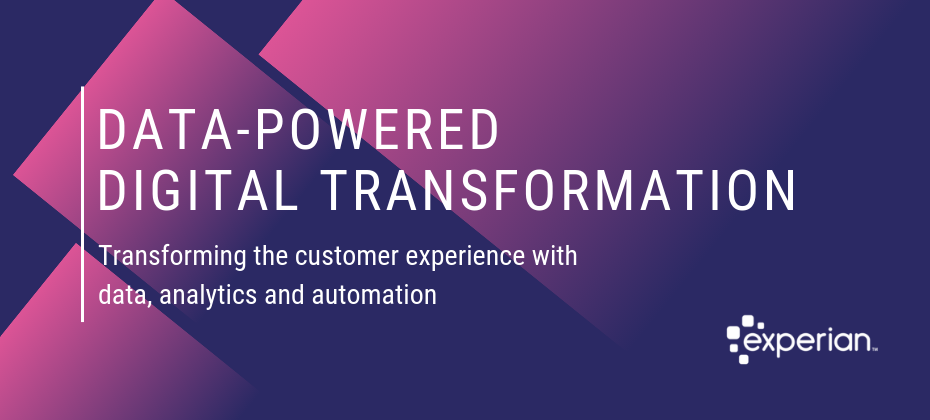Tag: data

Many may think of digital transformation in the financial services industry as something like emailing a PDF of a bank statement instead of printing it and sending via snail mail. After working with data, analytics, software and fraud-prevention experts, I have found that digital transformation is actually much more than PDFs. It can have a bigger and more positive influence on a business’s bottom line – especially when built on a foundation of data. Digital transformation is the new business model. And executives agree. Seventy percent of executives feel the traditional business model will disappear in the next five years due to digital transformation, according to recent Experian research. Our new e-book, Powering digital transformation: Transforming the customer experience with data, analytics and automation, says, “we live in a world of ‘evolve or fail.’ From Kodak to Blockbuster, we’ve seen businesses resist change and falter. The need to evolve is not new. What is new is the speed and depth needed to not only compete, but to survive. Digital startups are revolutionizing industries in months and years instead of decades and centuries.” So how do businesses evolve digitally? First, they must understand that this isn’t a ‘one-and-done’ event. The e-book suggests that the digital transformation life cycle is a never-ending process: Cleanse, standardize and enrich your data to create features or attributes Analyze your data to derive pertinent insights Automate your models and business practices to provide customer-centric experiences Test your techniques to find ways to improve Begin the process again Did you notice the key word or phrase in each of these steps is ‘data’ or ‘powered by data?’ Quality, reliable data is the foundation of digital transformation. In fact, almost half of CEOs surveyed said that lack of data or analytical insight is their biggest challenge to digital transformation. Our digital world needs better access to and insight from data because information derived from data, tempered with wisdom, provides the insight, speed and competitive advantage needed in our hypercompetitive environment. Data is the power behind digital transformation. Learn more about powering your digital transformation in our new e-book>

You’ve Got Mail! Probably a lot of it. Birthday cards from Mom, a graduation announcement from your third cousin’s kid whose name you can’t remember and a postcard from your dentist reminding you you’re overdue for a cleaning. Adding to your pile, are the nearly 850 pieces of unsolicited mail Americans receive annually, according to Reader’s Digest. Many of these are pre-approval offers or invitations to apply for credit cards or personal loans. While many of these offers are getting to the right mailbox, they’re hitting a changing consumer at the wrong time. The digital revolution, along with the proliferation and availability of technology, has empowered consumers. They now not only have access to an abundance of choices but also a litany of new tools and channels, which results in them making faster, sometimes subconscious, decisions. Three Months Too Late The need to consistently stay in front of customers and prospects with the right message at the right time has caused a shortening of campaign cycles across industries. However, for some financial institutions, the customer acquisition process can take up to 120 days! While this timeframe is extreme, customer prospecting can still take around 45-60 days for most financial institutions and includes: Bureau processing: Regularly takes 10-15 days depending on the number of data sources and each time they are requested from a bureau. Data aggregation: Typically takes anywhere from 20-30 days. Targeting and selection: Generally, takes two to five days. Processing and campaign deployment: Usually takes anywhere from three days, if the firm handles it internally, or up to 10 days if an outside company handles the mailing. A Better Way That means for many firms, the data their customer acquisition campaigns are based off is at least 60 days old. Often, they are now dealing with a completely different consumer. With new card originations up 20% year-over-year in 2019 alone, it’s likely they’ve moved on, perhaps to one of your competitors. It’s time financial institutions make the move to a more modern form of prospecting and targeting that leverages the power of cloud technology, machine learning and artificial intelligence to accelerate and improve the marketing process. Financial marketing systems of the future will allow for advanced segmentation and targeting, dynamic campaign design and immediate deployment all based on the freshest data (no more than 24-48 hours old). These systems will allow firms to do ongoing analytics and modeling so their campaign testing and learning results can immediately influence next cycle decisions. Your customers are changing, isn’t it time the way you market to them changes as well?

“We don’t know what we don’t know.” It’s a truth that seems to be on the minds of just about every financial institution these days. The market, not-to-mention the customer base, seems to be evolving more quickly now than ever before. Mergers, acquisitions and partnerships, along with new competitors entering the space, are a daily headline. Customers expect the same seamless user experience and instant gratification they’ve come to expect from companies like Amazon in just about every interaction they have, including with their financial institutions. Broadly, financial institutions have been slow to respond both in the products they offer their customers and prospects, and in how they present those products. Not surprisingly, only 26% of customers feel like their financial institutions understand and appreciate their needs. So, it’s not hard to see why there might be uncertainty as to how a financial institution should respond or what they should do next. But what if you could know what you don’t know about your customer and industry data? Sound too good to be true? It’s not—it’s exactly what Experian’s Ascend Analytical Sandbox was built to do. “At OneMain we’ve used Sandbox for a lot of exploratory analysis and feature development,” said Ryland Ely, a modeler at Experian partner client, OneMain Financial and a Sandbox user. For example, “we’ve used a loan amount model built on Sandbox data to try and flag applications where we might be comfortable with the assigned risk grade but we’re concerned we might be extending too much or too little credit,” he said. The first product built on Experian’s big data platform, Ascend, the Analytical Sandbox is an analytics environment that can have enterprise-wide impact. It provides users instant access to near real-time customer data, actionable analytics and intelligence tools, along with a network of industry and support experts to drive the most value out of their data and analytics. Developed with scalability, flexibility, efficiency and security at top-of-mind, the Sandbox is a hybrid-cloud system that leverages the high availability and security of Amazon Web Services. This eliminates the need, time and infrastructure costs associated with creating an internally hosted environment. Additionally, our web-based interface speeds access to data and tools in your dedicated Sandbox all behind the protection of Experian’s firewall. In addition to being supported by a revolutionized tech stack backed by an $825 million annual investment, Sandbox enables use of industry-leading business intelligence tools like SAS, RStudio, H2O, Python, Hue and Tableau. Where the Ascend Sandbox really shines is in the amount and quality of the data that’s put into it. As the largest, global information services provider, the Sandbox brings the full power of Experian’s 17+ years of full-file historical tradeline data, boasting a data accuracy rate of 99.9%. The Sandbox also allows users the option to incorporate additional data sets including commercial small business data and soon real estate data, among others. Alternative data assets add to the 50 million consumers who use some sort of financial service, in addition to rental and utility payments. In addition to including Experian’s data on the 220+ million credit-active consumers, small business and other data sets, the Sandbox also allows companies to integrate their own customer data into the system. All data is depersonalized and pinned to allow companies to fully leverage the value of Experian’s patented attributes and scores and models. Ascend Sandbox allows companies to mine the data for business intelligence to define strategy and translate those findings into data visualizations to communicate and win buy-in throughout their organization. But here is where customers are really identifying the value in this big data solution, taking those business intelligence insights and being able to take the resulting models and strategies from the Sandbox directly into a production environment. After all, amassing data is worthless unless you’re able to use it. That’s why 15 of the top financial institutions globally are using the Experian Ascend Sandbox for more than just benchmarking and data visualization but also risk modeling, score migration, share of wallet, market entry, cross-sell and much more. Moreover, clients are seeing time-savings, deeper insights and reduced compliance concerns as a result of consolidating their production data and development platform inside Sandbox. “Sandbox is often presented as a tool for visualization or reporting, sort of creating summary statistics of what’s going on in the market. But as a modeler, my perspective is that it has application beyond just those things,” said Ely. To learn more about the Experian Ascend Analytical Sandbox and hear more about how OneMain Financial is getting value out of the Sandbox, watch this on-demand webinar.

Picking up where we left off, online fintech lenders face the same challenges as other financial institutions; however, they continue to push the speed of evolution and are early adopters across the board. Here’s a continuation of my conversation with Gavin Harding, Senior Business Consultant at Experian. (Be sure to read part 1.) Part two of a two-part series: As with many new innovations, fintechs are early adopters of alternative data. How are these firms using alt data and what are the results that are being achieved? In a competitive market, alternative data can be the key to helping fintechs lend deeper and better reach underserved consumers. By augmenting traditional credit data, a lender has access to greater insights on how a thin-file consumer will perform over time, and can then make a credit decision based on the identified risk. This is an important point. While alternative data often helps lenders expand their universe, it can also provide quantitative risk measures that traditional data doesn’t necessarily provide. For example, alternative data can recognize that a consumer who changes residences more than once every two years presents a higher credit risk. Another way fintechs are using alternative data is to screen for fraud. Fraudsters are digitally savvy and are using technology to initiate fraud attacks on a broader array of lenders, in bigger volumes than ever before. If I am a consumer who wants to get a loan through an online fintech lender, the first thing the lender wants to know is that I am who I say I am. The lender will ask me a series of questions and use traditional data to validate. Alternative data takes authentication a step further and allows lenders to not only identify what device I am using to complete the application, but whether the device is connected to my personal account records – giving them greater confidence in validating my identity. A second example of using alternative data to screen for fraud has to do with the way an application is actually completed. Most individuals who complete an online application will do so in a logical, sequential order. Fraudsters fall outside of these norms – and identifying these patterns can help lenders increase fraud detection. Lastly, alternative data can help fintech lenders with servicing and collections by way of utilizing behavioral analytics. If a consumer has a history of making payments on time, a lender may be apt to approve more credit, at better terms. As the consumer begins to pay back the credit advance, the lender can see the internal re-payment history and recommend incremental line increases. From your perspective, what is the future of data and what should fintechs consider as they evolve their products? The most sophisticated, most successful “think tanks” have two things that are evolving rapidly together: Data: Fintechs want all possible data, from a quality source, as close to real-time as possible. The industry has moved from “data sets” to “data lakes” to “data oceans,” and now to “data universes.” Analytics: Fintechs are creating ever-more sophisticated analytics and are incorporating machine learning and artificial intelligence into their strategies. Fintechs will continue to look for data assets that will help them reach the consumer. And to the degree that there is a return on the data investment, they will continue to capitalize on innovative solutions – such as alternative data. In the competitive financial marketplace, insight is everything. Aite Group recently conducted a new report about alternative data that dives into new qualitative research collected by the firm. Join us to hear Aite Group’s findings about fintechs, banks, and credit unions at their webinar on December 4. Register today! Register for the Webinar Click here for more information about Experian’s Alternative Data solutions. Don’t forget to check out part one of this series here. About Gavin Harding With more than 20 years in banking and finance Gavin leverages his expertise to develop sophisticated data and analytical solutions to problem solve and define strategies across the customer lifecycle for banking and fintech clients. For more than half of his career Gavin held senior leadership positions with a large regional bank, gaining experience in commercial and small business strategy, SBA lending, credit and risk management and sales. Gavin has guided organizations through strategic change initiatives and regulatory and supervisory oversight issues. Previously Gavin worked in the business leasing, agricultural and construction equipment sectors in sales and credit management roles.

If your company is like many financial institutions, it’s likely the discussion around big data and financial analytics has been an ongoing conversation. For many financial institutions, data isn’t the problem, but rather what could or should be done with it. Research has shown that only about 30% of financial institutions are successfully leveraging their data to generate actionable insights, and customers are noticing. According to a recent study from Capgemini, 30% of US customers and 26% of UK customers feel like their financial institutions understand their needs. No matter how much data you have, it’s essentially just ones and zeroes if you’re not using it. So how do banks, credit unions, and other financial institutions who capture and consume vast amounts of data use that data to innovate, improve the customer experience and stay competitive? The answer, you could say, is written in the sand. The most forward-thinking financial institutions are turning to analytical environments, also known as a sandbox, to solve the business problem of big data. Like the name suggests, a sandbox is an environment that contains all the materials and tools one might need to create, build, and collaborate around their data. A sandbox gives data-savvy banks, credit unions and FinTechs access to depersonalized credit data from across the country. Using custom dashboards and data visualization tools, they can manipulate the data with predictive models for different micro and macro-level scenarios. The added value of a sandbox is that it becomes a one-stop shop data tool for the entire enterprise. This saves the time normally required in the back and forth of acquiring data for a specific to a project or particular data sets. The best systems utilize the latest open source technology in artificial intelligence and machine learning to deliver intelligence that can inform regional trends, consumer insights and highlight market opportunities. From industry benchmarking to market entry and expansion research and campaign performance to vintage analysis, reject inferencing and much more. An analytical sandbox gives you the data to create actionable analytics and insights across the enterprise right when you need it, not months later. The result is the ability to empower your customers to make financial decisions when, where and how they want. Keeping them happy keeps your financial institution relevant and competitive. Isn’t it time to put your data to work for you? Learn more about how Experian can solve your big data problems. >> Interested to see a live demo of the Ascend Sandbox? Register today for our webinar “Big Data Can Lead to Even Bigger ROI with the Ascend Sandbox.”

Big Data is no longer a new concept. Once thought to be an overhyped buzzword, it now underpins and drives billions in dollars of revenue across nearly every industry. But there are still companies who are not fully leveraging the value of their big data and that’s a big problem. In a recent study, Experian and Forrester surveyed nearly 600 business executives in charge of enterprise risk, analytics, customer data and fraud management. The results were surprising: while 78% of organizations said they have made recent investments in advanced analytics, like the proverbial strategic plan sitting in a binder on a shelf, only 29% felt they were successfully using these investments to combine data sources to gather more insights. Moreover, 40% of respondents said they still rely on instinct and subjectivity when making decisions. While gut feeling and industry experience should be a part of your decision-making process, without data and models to verify or challenge your assumptions, you’re taking a big risk with bigger operations budgets and revenue targets. Meanwhile, customer habits and demands are quickly evolving beyond a fundamental level. The proliferation of mobile and online environments are driving a paradigm shift to omnichannel banking in the financial sector and with it, an expectation for a customized but also digitized customer experience. Financial institutions have to be ready to respond to and anticipate these changes to not only gain new customers but also retain current customers. Moreover, you can bet that your competition is already thinking about how they can respond to this shift and better leverage their data and analytics for increased customer acquisition and engagement, share of wallet and overall reach. According to a recent Accenture study, 79% of enterprise executives agree that companies that fail to embrace big data will lose their competitive position and could face extinction. What are you doing to help solve the business problem around big data and stay competitive in your company?

Trivia question: Millennials don’t purchase new vehicles. True or False?

When it comes to driving the automotive industry forward, Experian Automotive has a motto: “The right cars. The right customers. The right data to know the difference.” We deliver an integrated perspective based on the highest quality automotive information and market intelligence. Data is important to us, and we have the most robust combination of data assets under one roof. The North American Vehicle Database℠, File One℠ Credit Database, Consumer View℠ Marketing Database, Online Activity Databases, and National Fraud Database℠ all fed into Experian’s Auto HyperConnect™. Auto HyperConnect houses two different solutions: Auto HyperTargeting™ and Auto HyperMonitoring™. There are four different components to Auto HyperTargeting, and the one we will focus on today is Expired Lease. Dealers have found success marketing to their own customers when vehicle leases come due. The challenge has been conquesting off-lease consumers who didn’t buy from them. While off-lease consumer marketing lists are available, they only provide the estimated lease end date and monthly lease payment. When restricted to this data, it’s hard to tell if a $550 a month payment is for a Ford F150 or a BMW 3-series. And yet this is exactly the level of detail needed to successfully target off-lease marketing. Experian’s new Auto HyperTargeting- Expired Lease addresses this challenge by enabling dealers to identify and engage off-lease audiences through a highly targeted approach that has never been possible! Now, finding customers is much easier and cost-effective. You can use the best mix of selection criteria to maximize your off-lease conquesting strategy. Some of the ways you can identify your audience are: Lease Maturity Date Vehicle Make Vehicle Model Zip Code Model Performance Tier Distance from Dealer Ship Vehicle Status (New or Used) Signing up for Auto HyperTargeting- Expired Lease comes with five perks. The first is a monthly file. This includes name and address, lease maturity date, make/model, monthly payment bands, and phone and email address when available. The second is the ability to make sign up for a subscription monthly payments. Third is marketing flexibility with direct mail, email, and phone. Four there is no firm offer of credit required for this. Finally, a quarterly sales report. ARA reports provide sales metrics industry wide for your targets. Other competitive features also available in Auto HyperTargeting- Expired Lease is the customers full contact information with name, address, email address and phone number. And for online and offline channels, you can select a specific audience that is customizable. Auto HyperTargeting has some amazing features to successfully conquest customers, and Expired Lease is one of the four ways to do this. Stay tuned for Auto HyperTargeting- Vehicle Owners coming up next!

When developing a risk model, validation is an essential step in evaluating and verifying a model’s predictive performance. There are two types of data samples that can be used to validate a model. In-time validation or holdout sample: Random partitioning of the development sample is used to separate the data into a sample set for development and another set aside for validation. Out-of-time validation sample: Data from an entirely different period or customer campaign is used to determine the model’s performance. We live in a complicated world. Models can help reduce that complexity. Understanding a model’s predictive ability prior to implementation is critical to reducing risk and growing your bottom line. Learn more

Data can be a powerful tool. But the key to data isn’t just accessing it. It’s interpreting it — and using it to make better decisions that benefit your business and your customers. Here are four key areas where business leaders can use data in more meaningful ways to impact decisions: Grow your business — Reveal patterns, trends and associations to better evaluate business opportunities and respond to market fluctuations. Improve efficiency — Optimize operations and improve use of time to acquire more customers for less. Manage fraud and credit risk — The better you know your customers, the less risk you’ll have. Validate manually entered information — Determine the best actions to deliver the most effective outcomes for both existing and future customers. According to Forbes, by the year 2020 about 1.7 megabytes of new information will be created every second for every human being.1 Get the most out of our data-driven economy to remain competitive. Learn more> 1Bernard Marr, “Your enterprise competes to win. Does your digital infrastructure?,” Forbes, September 2015.

When it comes to vehicle history reporting, there are many offerings on the table. Some are better known than others, but only one comes from the global leader in data-driven solutions. AutoCheck® vehicle history reports are backed by Experian Information Solutions and have many key features that competitors don’t have. You and your customers can make more confident decisions knowing that the vehicle’s history is backed by data from Experian. Selling is made easier by providing greater transparency which strengthens consumer confidence in your inventory and brand to sell more cars. Below, we will help you better understand the value of AutoCheck throughout your dealership and take you through the five best practices for using AutoCheck. AutoCheck Best Practice #1: Integrate AutoCheck in all your dealership’s applications and websites. The good thing about AutoCheck is the ease of integration within a dealership’s applications and websites. AutoCheck works with hundreds of software providers, meaning it is highly flexible with whatever your dealership is using. It doesn’t matter if the user is a buyer, manager, technician, or any other role at a dealership. There are no additional costs for multiple users since there is an unlimited number of users for a dealership. If a dealership works with someone that AutoCheck doesn’t already work with, Experian will still set the dealership up and work with them to make sure they have a seamless integration. AutoCheck Best Practice #2: Run an AutoCheck on every vehicle acquisition. Since AutoCheck is a vehicle history reporting software, it can uncover unknown history that could pass off to a dealer or a consumer. AutoCheck checks for multiple owners, title brands, open recalls, previous auction announcements, prior vehicle uses, odometer fraud, accidents and so much more! The reason why this is so important comes down to the number of vehicles in operation. Per NADA Data, there were over 264 million cars and light-duty trucks in operation in the United States in 20161. If approximately 20% of the cars and light-duty trucks on the road have been in an accident, that is over 50 million vehicles currently on the road that have been in an accident². The average diminished value of a vehicle in an accident is $3,0193. Finding only one accident per month you did not know about justifies and pays for the cost of an AutoCheck subscription. AutoCheck Best Practice #3: Promote your inventory with AutoCheck. AutoCheck can also be used to directly promote a dealer’s inventory. All a dealer does is integrate AutoCheck with their dealership’s website. An AutoCheck link is automatically added to every vehicle. There is no additional charge which provides savings to both the dealer and the consumer. The most current data is provided with every click to give feedback to dealers. AutoCheck is the only vehicle history provider on all the top online shopping sites. Consumers can look for AutoCheck on Autotrader℠, Cars.com™, CarGurus®, ebay™ Motors, Edmunds®, and Kelly Blue Book®. AutoCheck Best Practice #4: Build confidence in every sale with AutoCheck. The patented AutoCheck Score is a numerical rating summarizing the events about the vehicle. This helps dealers and consumers to compare vehicles of similar class and age based on a scale of 1 to 100. It also predicts the likelihood the car will be on the road in 5 years. The Score helps to understand a vehicle’s reliability as it pertains to the vehicle’s age, number of owners and accidents. When comparing two vehicles, it is also important to look at the Similar Vehicles Score. Even though a vehicle may have a score of 89 compared to a similar vehicle which scored an 85, the first vehicle may have a score range of 91-96. This would mean the vehicle that scored an 89 is lower than the average. The AutoCheck Score is based on many variables including age, vehicle class, mileage, number of owners, and vehicle use and event. Along with the AutoCheck Score, the BuyBack Protection program from AutoCheck will help build confidence. Experian will buy back a vehicle if the AutoCheck report fails to list certain brands available to Experian at the time the report was issued. This program is up to 110% of NADA Guides retail value, plus up to $500 in aftermarket accessories. Registered and qualified vehicles have this protection available at no cost and will have a badge on their report. AutoCheck Best Practice #5: Promote your service department by providing service data. The final aspect and best practice focuses on the service department and service data. Dealers can display services they have performed within AutoCheck. With AutoCheck, dealers and consumers can see that a vehicle has been well maintained with reported service data. Reporting service data provides an easy to understand format for customers and builds confidence for shoppers. All-in-all, AutoCheck can be used in every department successfully. To recap, these are the five best practices for AutoCheck. Integrate AutoCheck in all your dealership’s applications and websites. Run an AutoCheck on every vehicle. Promote your inventory with AutoCheck. Build consumer confidence in every sale with AutoCheck. Promote your service department and display service records on AutoCheck. ¹Source: NADA DATA, Annual General Overview 2016, page 3. https://www.nada.org/2016NADAdataHighlights/ ²Source: Experian Analysis, more than 18 % of cars and light duty trucks in operation have been in an accident. 3Source: Mitchell Industry Trends Report, Q1 2017, page 32 http://www.mitchell.com/Portals/0/Assets/industry-trends/itr-vol-17-no-1-winter-2017-apd.pdf

Data driven insights about your marketplace are critical to your success. For instance, data can be used to determine if your customers are loyal or if they are likely to defect to another dealership. According to Experian research, there were 54 million consumer vehicle sales transactions in 2017. While that may sound great, not all returning buyers are loyal. In fact, we found that three out of four people are not dealer loyal. Even though only ¼ of a dealer’s customer base regularly return, the remaining ¾ can be conquested. 41 million non-dealer loyal vehicle sales happened in 2017, meaning there were 41 million chances to conquest for dealers across the country. You may be asking yourself “that’s interesting, but how do I win?”. Start with best in class data. At Experian, we work with our North American Vehicle Database℠, File One℠ Credit Database, and Consumer View℠ Marketing Database. These databases have information including the history of 900 million vehicles in the United States and Canada, 10 billion vehicle history records, to consumer data about credit inquiries and data attributes for consumers and households. Figuring out how to increase customer loyalty and conquesting becomes simple once you consider Experian’s solution: Auto HyperConnect™. Auto HyperConnect is the answer to the question of “how do I use my data to win my market?” Our Auto HyperConnect suite includes two different products. The first is Auto HyperMonitoring™ which improves customer loyalty. The second is Auto HyperTargeting™, which offers four different ways to conquest vehicle owners: through owners/service, expired leases, off-loan, and current vehicle equity. Since there is a lot to talk about regarding conquesting vehicle owners, this will be a basic overview and we will go into detail later. Experian goes beyond providing quality data to our clients- we are your partner in the discovery of critical information to drive your success. The first step in our Auto HyperTargeting methodology starts with discovery - working with an Experian Automotive representative to create the most effective conquest strategy. After that, quantify and understand what data is available and how similar records have performed historically. Next, execute the strategy by launching campaigns to communicate with prospective customers via direct mail, email, and phone, etc. Finally, measure and track results with quarterly marketing attribution reporting with Experian’s Auto Response Analysis With Auto HyperTargeting, these six product benefits help it to stand apart from the competition: Highly targeted audiences and attributes lists closely fit prospecting profiles. These profiles include geography, vehicle make, vehicle class, and lease maturity data. Append 1,500+ demographic attributes, 650+ psychographics, and 70+ Mosaic segments. Complete, accurate, and actionable data is delivered timely. Data derived from the source with proprietary processes ensure that it’s the highest quality and best coverage. Flexible marketing execution has no firm offer of credit required and customizable messaging for relevancy. Full visibility performance tracking has closed loop ARAs delivered quarterly with performance details. Performance driven audience hyper targeting approach gets dealers the closest to the customer as possible while saving time and money. Focusing on marketing strategy and tactics delivers results and eliminates waste from unproductive volume/cost opportunities. Finally, the competitive advantage takes market share away from the competition by identifying, engaging, and converting the right prospects. Briefly, here are the four different types of conquesting a dealer can do with Auto HyperTargeting: Expired Lease lets a dealer conquest new prospects based on customized input criteria including zip codes, vehicle makes and classes, and lease maturity data with the marketing flexibility necessary to drive engagement and win new customers. There is no firm offer of credit required. Vehicle Owners lets a dealer engage with current owners to enable new relationships and opportunities. These opportunities reach out to service and parts, aftermarket accessories, new/used car, warranty, insurance, and financial services. Vehicle Equity identifies, engages, and acquires new customers with positive vehicle equity status and maximizes sales opportunities. Getting consumers into a new vehicle, into re-finance solutions, into new loans, and get third party offers in front of consumers are all apart of vehicle equity. End of Loan connects dealers with consumers who are reaching the end of their loan term and help them transition into their new vehicle of choice. These include customized offers, getting consumers into a new vehicle, getting consumers into new loans, and getting third party offers in front of consumers. Juggling the requirements to both maintain customer loyalty and conquest for new ones can be difficult, but our Auto HyperConnect suite helps dealers to succeed at both. In our upcoming mini-series on conquesting with Auto HyperTargeting, we will detail it’s four core capabilities in more detail to help dealers to conquest with confidence.

Who is the ideal dealership customer? Wouldn’t they be one that buys or leases a car and becomes a repeat customer? Loyal customers are ideal because they prefer to go to your dealership to purchase a vehicle, get their vehicle serviced, and even have their family and friends purchase from you. This brings up an important question: what is customer loyalty worth to you? According to the White House Office of Consumer Affairs, on average, loyal customers are worth up to 10 times as much as their first purchase. They also found that it is six to seven times more expensive to acquire a new customer than it is to keep a current one. Marketing Metrics found the probability of selling to a new prospect is only between 5-20%. But if you are selling to an existing customer, the probability rises to 60-70%. So, knowing this, what holds dealers back from actively conquesting loyal customers? Time, money, resources, expertise, priority, process and systems, and data are the key factors that keep them from pursuing these ideal customers. Even though you may stare across the street at them every day, you must remember that your competition is much bigger than the dealerships next door to you. According to recent Experian® research, Whether it is a new, certified used, or non-certified used vehicle, auto manufacturers will have the highest level of loyalty by owned vehicle acquisition. Next to that, you have the Make of a vehicle followed the Model. Dealerships rank last in loyalty against these major factors. This leads to asking a few “what-ifs”. What if you have the unique opportunity to improve customer loyalty, make more money, and prevent defection to the competition? What if you had actionable insights to know your customer’s buying and loyalty propensities with a high degree of accuracy? How about if you had knowledge of timing on when to engage with your customers to appropriately deliver the right message and offers with the highest potential conversion rate? Finally, what if you had an easy, cost-effective, yet powerful way to unify big data relating to consumer, vehicle, and market and your customer data to make better marketing decisions? Thanks to Experian® and Auto HyperConnect™, you don’t have to ask those questions anymore. Auto HyperConnect leverages the most robust combination of data assets under one roof. Our loyalty component is called Auto HyperMonitoring™ and takes loyalty to the next level. Auto HyperMonitoring is an event-based customer loyalty measurement solution that gives you the ability to more effectively manage and strengthen your customer retention efforts. With insights derived from the monitoring of both macro- and micro-environments relating to the vehicle, consumer events, and the overall automotive landscape, clients can quickly gain a deep understanding of consumer loyalty propensities and can create and execute initiatives that maximize their customer loyalty opportunities. Starting with a client’s customer file, Auto HyperMonitoring provides data hygiene that verifies the VIN matches the customer household and will only monitor the VINS that have a match. Next, there is monitoring for vehicle events such as accidents or airbags going off. Consumer events equate to having a baby or moving. Market events involve incentives, OEM loyalty, and warranty expiration. Data events are phone numbers, email address, or VIN verification through the hygiene process.. These events feed into the creation of analysis & insights to identify your customers’ behavioral patterns attributed to loyalty, purchasing, and other factors. When key opportunities are identified, there is client notification. This is used to manage the customer relationship and loyalty through a dealer’s CRM system and comes in an email. How you would use Auto HyperMonitoring? It can be used to bring customers back into the showroom or service lanes in a few different ways. Initially, Dealers can call consumers to open the lines of communication. Next, sending consumers emails and direct mail with special offers are both effective. Finally, Auto HyperMonitoring can also be used to activate digital media targeting campaigns to better reach them where they’re spending their time. Finally, we have the product benefits of Auto HyperMonitoring. First off, it enhances customer engagement & loyalty. By proactively engaging with clients at the right moment based on important and relevant vehicle, customer, and market-related event triggers, loyalty can be systematically strengthened. Second, it improves marketing efficiency. Knowing when to engage with your customer base to minimizes the risk of over and under marketing exposure; improve conversion and reduce cost. Third, complete, accurate, & actionable data is delivered in a timely manner. Auto HyperMonitoring leverages both a client’s customer file and Experian’s rich data assets to enable a complete view of customer opportunities. Finally, Auto HyperMonitoring compliments and supports OEM/dealer loyalty programs. Maximizing revenue opportunities by achieving/surpassing OEM/Dealer loyalty program goals is possible with Auto HyperMonitoring. Customer loyalty is important and will directly impact dealership sales in both your showroom and your service lanes – including the benefit of referral customers. The challenges of competing with manufacturers and other dealerships are mitigated with Experian’s Auto HyperConnect suite and Auto HyperMonitoring. With these, you will have greater success when targeting customer loyalty and using data to keep the relationship between the dealership and the customer alive.

The auto industry is blessed with an abundance of data - market research, demand estimates, demographic trends, registration history, not to mention your dealership's own sales and inventory data. Dealers are often visual people - who love beautiful cars more than boring spreadsheets. The more visual you can make your data, the easier it will be to make decisions based on what it's telling you. Here are the five steps to being a data-driven dealer. 1. Where am I selling the most cars? You probably have a good instinct about where the "hot spots" are around your dealership. But there's a reason many dealers often display a map somewhere in the dealership, with pushpins representing recent new and used sales. It's a tried-and-true technique because there's no substitute for a visual representation of data, especially to get a good sense of where you're currently successful. More importantly, it will also help you answer a critical question - where should I be selling the most cars? By layering your web stats, such as Google Analytics, on top of your sales data, you can start to see whether your PPC spend is resulting in sales. Then layer on registration data to understand whether you're maximizing opportunity in your own backyard. You might already be selling a lot of cars into a town, but looking at your on-brand market share will help you determine if you've fully penetrated the area. Looking at overall market activity, not just your own data, is required to understand where you fit into the bigger picture and decide upon your best sales strategy. 2. Where should we be conquesting? Once you've confirmed that you're (hopefully) dominating in your town and those directly adjacent to you, it's time to turn your eye to how to take on competitive dealerships farther afield. Again, data can help you determine next steps and target your budget appropriately. Every dealership approaches and defines "conquesting" a little differently, but there are two common techniques that can be made much easier using recent registration statistics. First, look for ZIP Codes outside of your immediate PMA that are selling a high number of on-brand vehicles. These are your competitors' happiest hunting grounds; focus on enticing shoppers in those areas to drive a little further to take advantage of special pricing or promotions, rather than attacking blindly in a 20-mile radius. 3. What is my best performing campaign now? No matter what your position is at the dealership, you need to know what's working best at any given moment. The GM needs to be able to make on-the-fly budgeting decisions, while the e-commerce Director wants to know which campaigns are working and what to do more of. But too often, the only objective measures we're regularly provided are traffic stats. Traffic is important, of course, but we'd suggest there are three factors dealers should evaluate for every campaign. A campaign may be driving lots of shoppers to your site, but if they're immediately leaving the site, they aren't worth much for you. A high bounce rate is your first sign that something is amiss since shoppers aren’t finding what they were looking for on your site. A second-level analysis involves looking at what other pages visitors looked at after hitting the campaign landing page. For an offer focused on a specific vehicle, visitors should be moving on to look at inventory on VDP pages. Free oil change promotion? Visitors should be spending time on the service portion of your site. Work with your agency or internal e-commerce team to determine what content, language and images are the most effective at engaging potential buyers to take the desired action. Speaking of action, conversion rate is your single best measure of whether a campaign is performing to expectations. Just make sure you're measuring actions that matter: Form submissions, email leads, mobile clicks to call, and visits to hours and directions pages all indicate various levels of positive customer interest in beginning a dialogue. 4. How do I determine whether my traditional advertising spend is producing results? Measuring dealer marketing ROI can be challenging, especially for traditional advertising. History tells us that radio, TV, newspaper, and outdoor are successful in driving demand, but quantifying that effect can be an elusive goal. But there are methods that will get you closer to determine the effect of your traditional efforts on sales. By tagging the start dates of all your marketing activities and mapping them on a trendline of your traffic for your URLs, leads such as phone calls, chat, and coupon codes for your service department as well as sales, you'll get a good sense about whether your offline campaigns are generating online interest. 5. Who is my ideal customer? Once you understand which models are likely to move next month, your next question should be: "Who am I selling to?" You probably have a good sense of your typical customer profile for many models (there's a good chance you're showing minivans and SUVs to young families, for example). But do you know where those customers live? And how to best talk to them? There is an incredible amount of data available on consumers, from credit history to buying behavior to lifestyle preferences. So how do you make use of this rich consumer data? At a basic level, Experian data can tell you a lot about the residents of each ZIP Code surrounding your dealership - from average age, income, and number of children, all the way to the most prevalent Mosaic® profiles in each town. In a previous article, we talk about locating your ideal customer using Mosaic profiles. You might have a high number of "American Royalty" in one area, or an abundance of "Sports Utility Families" just a couple of towns over. This information can tell you not only where you might want to market particular models, but what medium and messaging will resonate best in each area. While only 15 miles apart, the Boston suburbs of Sudbury and Norwood are home to very different types of BMW buyers, suggesting vastly different marketing campaigns to best appeal to each. Data is a necessary tool for understanding your ideal customer, improving your marketing results, and selling more vehicles. These five steps to becoming a data-driven dealer address all your requirements to enrich your marketing and conquest more successfully.
